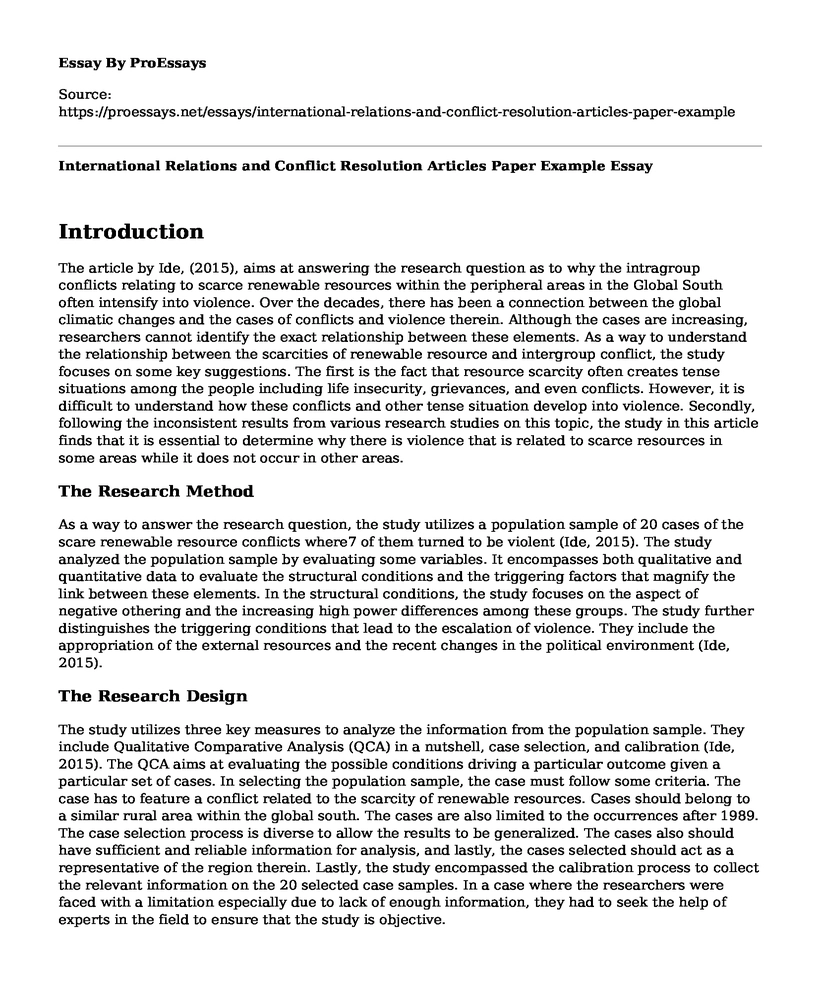Introduction
The article by Ide, (2015), aims at answering the research question as to why the intragroup conflicts relating to scarce renewable resources within the peripheral areas in the Global South often intensify into violence. Over the decades, there has been a connection between the global climatic changes and the cases of conflicts and violence therein. Although the cases are increasing, researchers cannot identify the exact relationship between these elements. As a way to understand the relationship between the scarcities of renewable resource and intergroup conflict, the study focuses on some key suggestions. The first is the fact that resource scarcity often creates tense situations among the people including life insecurity, grievances, and even conflicts. However, it is difficult to understand how these conflicts and other tense situation develop into violence. Secondly, following the inconsistent results from various research studies on this topic, the study in this article finds that it is essential to determine why there is violence that is related to scarce resources in some areas while it does not occur in other areas.
The Research Method
As a way to answer the research question, the study utilizes a population sample of 20 cases of the scare renewable resource conflicts where7 of them turned to be violent (Ide, 2015). The study analyzed the population sample by evaluating some variables. It encompasses both qualitative and quantitative data to evaluate the structural conditions and the triggering factors that magnify the link between these elements. In the structural conditions, the study focuses on the aspect of negative othering and the increasing high power differences among these groups. The study further distinguishes the triggering conditions that lead to the escalation of violence. They include the appropriation of the external resources and the recent changes in the political environment (Ide, 2015).
The Research Design
The study utilizes three key measures to analyze the information from the population sample. They include Qualitative Comparative Analysis (QCA) in a nutshell, case selection, and calibration (Ide, 2015). The QCA aims at evaluating the possible conditions driving a particular outcome given a particular set of cases. In selecting the population sample, the case must follow some criteria. The case has to feature a conflict related to the scarcity of renewable resources. Cases should belong to a similar rural area within the global south. The cases are also limited to the occurrences after 1989. The case selection process is diverse to allow the results to be generalized. The cases also should have sufficient and reliable information for analysis, and lastly, the cases selected should act as a representative of the region therein. Lastly, the study encompassed the calibration process to collect the relevant information on the 20 selected case samples. In a case where the researchers were faced with a limitation especially due to lack of enough information, they had to seek the help of experts in the field to ensure that the study is objective.
The Study Findings
The research findings affirm the presence of negative othering, low power differences, and the recent political changes are sufficient causes that make the intergroup conflicts due to scare renewable resources escalate to violence (Ide, 2015).
The Advantages and Disadvantages of the Research Design
The QCA is advantageous as it helps the researchers to determine the conditions that make the scarcity of the renewable resource to intensify into violence. Nonetheless, the QCA has some limitations since it does not account for any possible errors that may arise during the analysis process. Also, the case selection criteria are beneficial as it allows the study to be objective. The calibration process allows the researchers to acquire relevant and sufficient information concerning the cases selected.
References
Ide, T. (2015). Why do conflicts over scarce renewable resources turn violent? A qualitative comparative analysis. Global Environmental Change, 33, 61-70. doi: 10.1016/j.gloenvcha.2015.04.008
Cite this page
International Relations and Conflict Resolution Articles Paper Example. (2022, Sep 22). Retrieved from https://proessays.net/essays/international-relations-and-conflict-resolution-articles-paper-example
If you are the original author of this essay and no longer wish to have it published on the ProEssays website, please click below to request its removal:
- Why Felons Voting Right Laws Should Change
- Should Cities Pay for Sport Facilities? - Paper Example
- Cultural Competence Through Multiculturalism Essay Example
- Who U.S. Influence Foreign Policy? - Essay Sample
- Reforms Impacting Public Sector Unions: Effects on Employees, Employers & Taxpayers - Essay Sample
- UK Government: Monarch State With Queen Elizabeth II - Essay Sample
- Insights on the Death Penalty: A Brief Review of Scholarly Perspectives - Annotated Bibliography Sample







